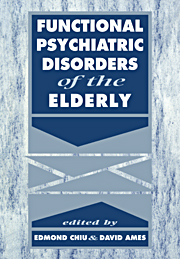Book contents
- Frontmatter
- Contents
- List of contributors
- Preface
- Introduction – A personal note
- Acknowledgement
- Part 1 Classification
- Part 2 General epidemiology
- Part 3 Neuroses
- Part 4 Affective disorders
- Part 5 Psychosexual disorders
- Part 6 Substance use and abuse
- Part 7 Schizophrenia and related psychoses
- Part 8 Psychological, biological and medical issues
- 20 A developmental psychology of old age
- 21 The biology of functional psychiatric disorders
- 22 Brain imaging in functional psychiatric disorders of the elderly
- 23 Medical co-morbidity: presentation in a general hospital setting
- 24 Psychiatric aspects of cerebro-vascular disease
- Part 9 Treatment methods
- Part 10 Conclusion
- Index
22 - Brain imaging in functional psychiatric disorders of the elderly
from Part 8 - Psychological, biological and medical issues
Published online by Cambridge University Press: 13 November 2009
- Frontmatter
- Contents
- List of contributors
- Preface
- Introduction – A personal note
- Acknowledgement
- Part 1 Classification
- Part 2 General epidemiology
- Part 3 Neuroses
- Part 4 Affective disorders
- Part 5 Psychosexual disorders
- Part 6 Substance use and abuse
- Part 7 Schizophrenia and related psychoses
- Part 8 Psychological, biological and medical issues
- 20 A developmental psychology of old age
- 21 The biology of functional psychiatric disorders
- 22 Brain imaging in functional psychiatric disorders of the elderly
- 23 Medical co-morbidity: presentation in a general hospital setting
- 24 Psychiatric aspects of cerebro-vascular disease
- Part 9 Treatment methods
- Part 10 Conclusion
- Index
Summary
The development of noninvasive computerized brain imaging techniques and their application to functional psychiatric disorders such as depression and schizophrenia represents one of the most important research advances in psychiatry over the past two decades. This chapter reviews the results of reported brain imaging studies of depression, schizophrenia and schizophrenia-like illnesses in the elderly.
X-ray computer tomography studies
In cranial Computed Tomography (CT), an X-ray source is moved around the head in the transverse plane, and detectors directly opposite the source record the quantity of radiation that has passed through the head. From a large series of such readings, a two-dimensional image made up of scanned squares, or pixels, is built up and represents a transverse slice of the head 5–10 mm thick. Most CT scanners produce an image of 256 × 256 pixels. CT scanning is cheap, widely available, involves a scanning time of only around 10 minutes and is generally well tolerated by subjects. There have been a large number of studies of CT in depression in both young, elderly and mixed age populations of patients. Despite varying methodology, both in terms of patient and control selection and method of measurement of anatomical structures (hand tracing, mechanical planimetry or computerized quantification), the results are in general agreement.
Depression
In an early CT study of elderly depressed patients, Jacoby & Levy (1980) examined the scans of 41 patients diagnosed with the Geriatric Mental State Schedule (GMS) (Copeland et al. 1976) and 50 healthy age-matched controls.
- Type
- Chapter
- Information
- Functional Psychiatric Disorders of the Elderly , pp. 377 - 388Publisher: Cambridge University PressPrint publication year: 1994



